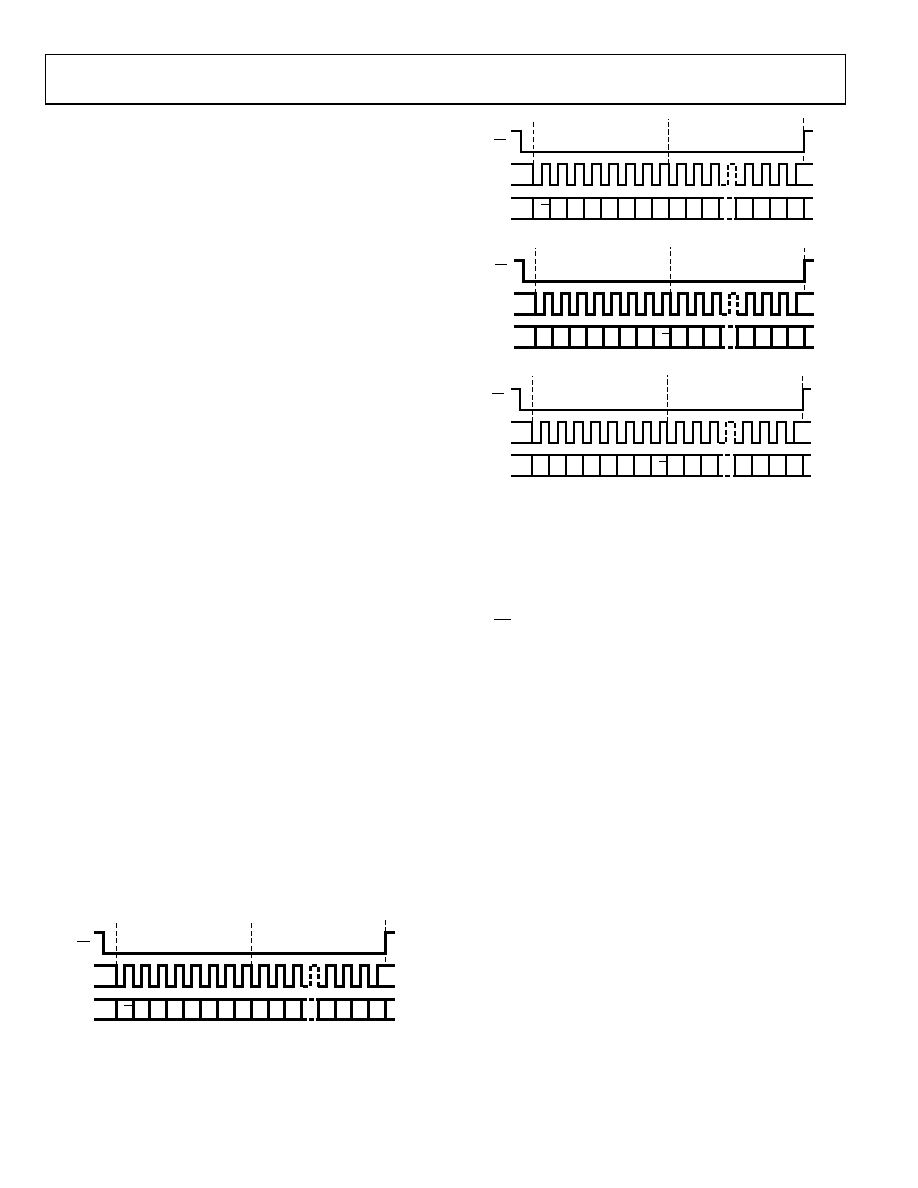- 您現(xiàn)在的位置:買賣IC網(wǎng) > PDF目錄17059 > AD9114-DPG2-EBZ (Analog Devices Inc)IC DAC DUAL 8BIT LO PWR 40LFCSP PDF資料下載
參數(shù)資料
| 型號: | AD9114-DPG2-EBZ |
| 廠商: | Analog Devices Inc |
| 文件頁數(shù): | 28/52頁 |
| 文件大?。?/td> | 0K |
| 描述: | IC DAC DUAL 8BIT LO PWR 40LFCSP |
| 標(biāo)準(zhǔn)包裝: | 1 |
| 系列: | TxDAC® |
| DAC 的數(shù)量: | 2 |
| 位數(shù): | 8 |
| 采樣率(每秒): | 125M |
| 數(shù)據(jù)接口: | 串行 |
| DAC 型: | 電流 |
| 工作溫度: | -40°C ~ 85°C |
| 已供物品: | 板 |
| 已用 IC / 零件: | AD9114 |
第1頁第2頁第3頁第4頁第5頁第6頁第7頁第8頁第9頁第10頁第11頁第12頁第13頁第14頁第15頁第16頁第17頁第18頁第19頁第20頁第21頁第22頁第23頁第24頁第25頁第26頁第27頁當(dāng)前第28頁第29頁第30頁第31頁第32頁第33頁第34頁第35頁第36頁第37頁第38頁第39頁第40頁第41頁第42頁第43頁第44頁第45頁第46頁第47頁第48頁第49頁第50頁第51頁第52頁

AD9114/AD9115/AD9116/AD9117
Data Sheet
Rev. C | Page 34 of 52
MSB/LSB TRANSFERS
The serial port of the AD9114/AD9115/AD9116/AD9117 can
support both most significant bit (MSB) first or least significant
bit (LSB) first data formats. This functionality is controlled by the
LSBFIRST bit (Register 0x00, Bit 6). The default is MSB first
(LSBFIRST = 0).
When LSBFIRST = 0 (MSB first), the instruction and data bytes
must be written from the most significant bit to the least significant
bit. Multibyte data transfers in MSB first format start with an
instruction byte that includes the register address of the most
significant data byte. Subsequent data bytes should follow in
order from a high address to a low address. In MSB first mode,
the serial port internal byte address generator decrements for
each data byte of the multibyte communications cycle.
When LSBFIRST = 1 (LSB first), the instruction and data bytes
must be written from the least significant bit to the most significant
bit. Multibyte data transfers in LSB first format start with an
instruction byte that includes the register address of the least
significant data byte followed by multiple data bytes. The serial
port internal byte address generator increments for each byte of
the multibyte communication cycle.
If the MSB first mode is active, the serial port controller data
address of the AD9114/AD9115/AD9116/AD9117 decrements
from the data address written toward 0x00 for multibyte I/O
operations. If the LSB first mode is active, the serial port controller
address increments from the data address written toward 0x1F
for multibyte I/O operations.
SERIAL PORT OPERATION
The serial port configuration of the AD9114/AD9115/AD9116/
AD9117 is controlled by Register 0x00. It is important to note
that the configuration changes immediately upon writing to the
last bit of the register. For multibyte transfers, writing to this
register can occur during the middle of the communications
cycle. Care must be taken to compensate for this new configu-
ration for the remaining bytes of the current communications cycle.
The same considerations apply to setting the software reset bit
(Register 0x00, Bit 5). All registers are set to their default values
except Register 0x00, which remains unchanged.
Use of single-byte transfers or initiating a software reset is
recommended when changing serial port configurations to
prevent unexpected device behavior.
R/W N1N0A4 A3 A2 A1 A0 D7N D6N D5N
D00
D10
D20
D30
INSTRUCTION CYCLE
DATA TRANSFER CYCLE
CS
SCLK
SDIO
07
46
6-
29
1
Figure 85. Serial Register Interface Timing, MSB First Write
R/W N1N0A4A3 A2 A1 A0 D7N D6N D5N
D00
D10
D20
D30
INSTRUCTION CYCLE
DATA TRANSFER CYCLE
CS
SCLK
SDIO
07
466
-386
Figure 86. Serial Register Interface Timing, MSB First Read
A0 A1 A2 A3 A4 N0 N1 R/W D00 D10 D20
D7N
D6N
D5N
D4N
INSTRUCTION CYCLE
DATA TRANSFER CYCLE
SCLK
SDIO
0
74
66
-289
CS
Figure 87. Serial Register Interface Timing, LSB First Write
A0 A1 A2 A3 A4 N0 N1 R/W D00 D10 D20
D7N
D6N
D5N
D4N
INSTRUCTION CYCLE
DATA TRANSFER CYCLE
SCLK
SDIO
CS
07
46
6-
38
8
Figure 88. Serial Register Interface Timing, LSB First Read
PIN MODE
The AD9114/AD9115/AD9116/AD9117 can also be operated
without ever writing to the serial port. With RESET/PINMD
(Pin 35) tied high, the SCLK pin becomes CLKMD to provide
for clock mode control (see the Retimer section), the SDIO
pin becomes FORMAT and selects the input data format, and
the CS/PWRDN pin serves to power down the device. The
pins are not latched at power up. If you change the format, it
should change with about a 1μs delay.
Operation is otherwise exactly as defined by the default register
values in Table 13; therefore, external resistors at FSADJI and
FSADJQ are needed to set the DAC currents, and both DACs
are active. This is also a convenient quick checkout mode. DAC
currents can be externally adjusted in pin mode by sourcing or
sinking currents at the FSADJI/AUXI and FSADJQ/AUXQ
pins, as desired, with the fixed resistors installed. An op amp
output with appropriate series resistance is one of many
possibilities. This has the same effect as changing the resistor
value. Place at least 10 kΩ resistors in series right at the DAC
to guard against accidental short circuits and noise
modulation. The REFIO pin can be adjusted ±25% in a similar
manner, if desired.
發(fā)布緊急采購,3分鐘左右您將得到回復(fù)。